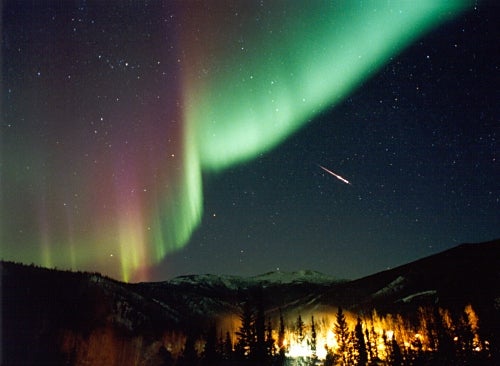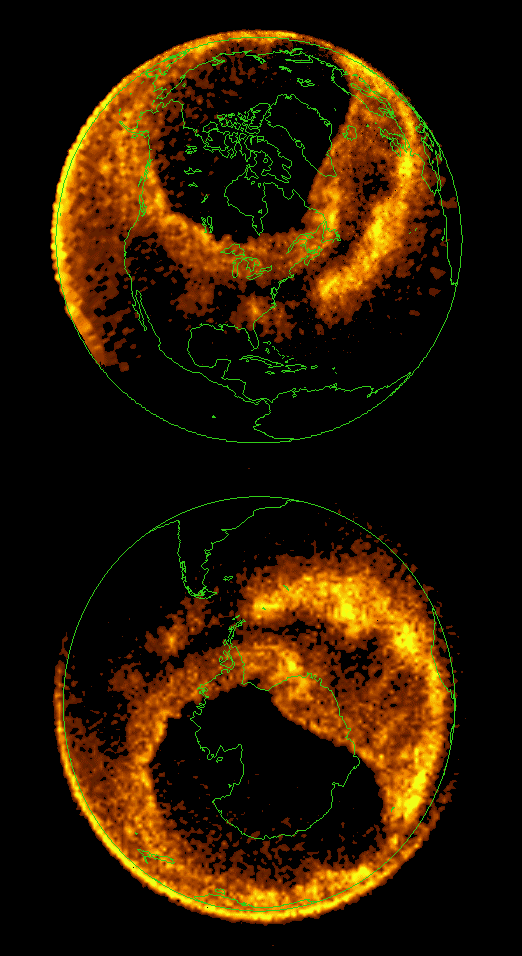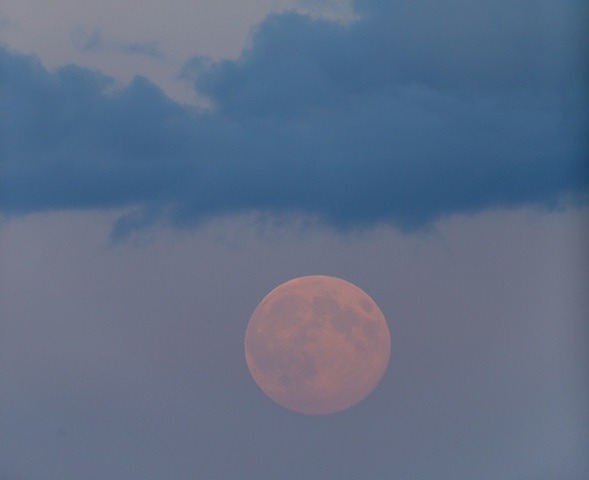Many historical accounts of the northern lights from areas far south of its usual location exist. An early Chinese record describes it as a “red cloud spreading all over the sky.” The Roman philosopher Seneca wrote that an aurora in a.d. 37 tricked the emperor into sending troops to aid what he thought was the burning seaport of Ostia, “when the glowing of the sky lasted through a great part of the night, shining dimly like a vast and smoking fire.” In 1583, similar “fires in the air” mobilized thousands of French pilgrims, who prayed to avert the wrath of God. On September 15, 1839, an intense aurora dispatched firefighters throughout London.
Aurorae occur in two great luminous ovals centered on Earth’s north and south magnetic poles. Collisions between atmospheric gases and showers of electrons and protons guided by Earth’s magnetic field set the ovals aglow, typically between heights of 62 and 155 miles (100 to 250 kilometers). Each gas gives out a characteristic color when bombarded. Excited oxygen atoms give off yellow-green light, the color most commonly observed. Ionized molecular nitrogen emits blue and violet light, colors to which the human eye is less sensitive. At lower altitudes, excited molecules of nitrogen and oxygen glow with a vivid red. These three primary colors together produce the myriad hues of a typical aurora.
What causes the showers of charged particles that create the northern lights? Ultimately, the source lies in the solar wind, a fast-moving stream of particles constantly flowing from the Sun that carries the Sun’s magnetic field out into space. The solar wind, typically moving at 250 miles (400 kilometers) per second, flows past Earth’s magnetic field and molds it into an elongated bubble or cavity, compressing its sunward side and stretching its night side far beyond the Moon’s orbit. Under certain conditions, the solar wind’s magnetic field can merge with Earth’s, creating electrical currents that drive protons and electrons into the polar atmosphere. Powerful events occurring on the Sun can drive enormous changes in the solar wind, increasing both its speed and density and enhancing its effect on Earth.
Understanding just how Earth’s magnetic field responds to such events is now a focus of much solar and space research. We are increasingly dependent on technologies that are extremely sensitive to changes in the space environment, changes often collectively referred to as “space weather.” The story of Galaxy 4, a heavily used communications satellite, serves as a good example. At 22h UT on May 19, 1998, while in geostationary orbit above the central United States, Galaxy 4 lost its primary and backup attitude control systems. At the time, Galaxy 4 handled about 80 percent of all U.S. pager traffic. Controllers could no longer maintain a stable link between the satellite and Earth, resulting in a loss of pager service to an estimated 45 million customers. Researchers believe the incident occurred because a sequence of solar events about two weeks prior to the failure created an extremely energetic cloud of electrons that wreaked havoc with the satellite.
Transient events on the Sun can generate fast-moving clouds of particles that greatly intensify the solar wind’s impact on Earth. Solar flares may blast material from the Sun’s surface for hours. Areas called coronal holes generate broad torrents of solar wind and may last for many months. But the most dramatic space-weather effects arise when enormous clouds of material erupt from the solar atmosphere and race to Earth. Scientists call these eruptions coronal mass ejections, or CMEs. Somehow, a portion of the Sun’s magnetic field undergoes a sudden disruption, stretching and twisting like a rubber band until it snaps. When it does, as much as one billion tons of matter blast away from the Sun at speeds up to 1,250 miles (2,000 km) a second. When a CME slams into Earth’s magnetic bubble, it pushes the sunward side closer to Earth and triggers other sudden changes. The result is a surge of particles into Earth’s atmosphere — a geomagnetic storm. Sometimes a fast CME will overtake and merge with one or more CMEs already on their way, resulting in a “cannibal” CME that can have an especially dramatic effect. Particularly powerful storms cause the auroral ovals to expand and move southward from their normal locations, bringing the northern lights to skywatchers at far lower latitudes than normal.
“Two instruments on SOHO have proved to be especially valuable for continuous real-time monitoring of solar storms that affect space weather,” says Paal Brekke, a SOHO project scientist. These are the Extreme ultraviolet Imaging Telescope (EIT) — which provides images of the solar surface at far ultraviolet wavelengths that are blocked by Earth’s atmosphere — and the Large Angle and Spectrometric Coronagraph (LASCO) — which looks for the enormous bubbles of charged particles and entrained magnetic field that represent a CME. Before SOHO was operational, only 27 percent of major magnetic storms were forecast correctly, and most forecasts were false alarms. Between 1996 and 1997, SOHO detected more than two dozen CMEs. “Over 85 percent [of these CMEs] caused major magnetic storms,” Brekke says, “and only 15 percent of such storms were not predicted.” Because geomagnetic storms can affect radio communications and navigation signals — and even introduce errors in positions determined by the Global Positioning Satellite network — advance notice is increasingly important as our reliance on such technology grows.
Coronal mass ejections, solar flares, and coronal holes tend to be more frequent on the active side of the Sun’s 11-year sunspot cycle. This cycle peaked in 2000, with a secondary maximum in 2002, which means solar activity is now on the downswing and will continued to decline until 2006. Activity is now slowly rise as the Sun powers up for its next maximum early in or after 2010.
Overall, the chances of seeing an aurora are not all that bad — especially in Canada and the United States. Because the north magnetic pole lies in North America, the auroral oval generally reaches farther south there. This means observers at a given latitude in North America have a better chance of seeing an aurora than those at the same latitude in Europe or Asia. Both Rome and Chicago lie at a latitude of 42°, for example, but Rome averages one aurora per decade while Chicago could see about ten each year.
A rapidly shifting and expanding auroral oval can induce electrical currents in other long conductors as well. An example that has become legend in the space-weather community occurred in March 1989, when an extremely active solar region broke records held for more than 30 years: Auroral activity was seen as far south as Jamaica. In Quebec, Canada, aurora-induced currents flowed through seven 100-ton capacitors operated by the Hydro-Quebec Power Authority, causing their protective relays to detect an overload condition. When the relays kicked in and took the devices off-line, about half of Quebec’s available electrical power went with them. Less than one minute later, the entire power-distribution system collapsed, leaving some 6 million people without electricity for more than 9 hours.
And the blackout could have expanded farther. “The power pools that served the entire northeastern United States were uncomfortably close to a cascading system collapse,” says Paal Brekke. Beyond power problems, induced currents also can weaken welds in oil pipelines and create damaging electrical surges in telecommunications cables.
A bright aurora is a feast for the eyes, but it is also a reminder of the powerful forces and tremendous energies routinely at work just a few miles above our heads.











